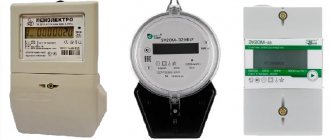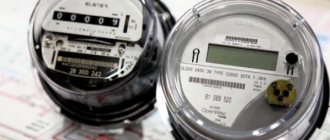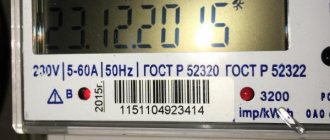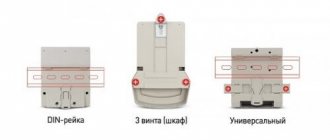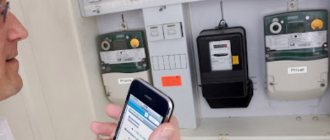The Mercury 200 meter is a single-phase and multi-tariff device that takes into account the active type and power characteristics of the consumed alternating current electrical energy. The device can be used in the private sector, MKD apartments, public institutions and other individual consumers.
Meter type – Mercury 200
Design and principle of operation
The product includes the following components:
- frame;
- contact block with shunt;
- electronic board with an amplifier chip, power supply, backup battery, microcontroller, internal memory, control circuit for connecting a third-party device, modem and optocoupler;
Block diagram of the meter - Mercury 200 - liquid crystal display.
The parameters of the electricity passing through the device are processed by an electronic board, from where the data is sent to the liquid crystal display, interface and modem (for individual modifications).
Lifehack for working with the Mercury 200 counter
Sometimes you may encounter unexpected moments that can confuse even those who know how to take readings. For example, when your counter went around for the second time or went to zero. In order for you to take readings, do the following:
- Write down the data displayed by tariff.
- Place a “1” in front of them. You might end up with the following (this is an example) 100050.
- Subtract the readings of last month from this value.
- As a result, you will receive the necessary indicators that you can transfer and pay for.
You can apply the same scheme not only with Mercury; it is suitable for any model where the indicators are displayed in a five-digit parameter.
Specifications
| Characteristics | Magnitude |
| Rated voltage (Unom), V | 230 |
| Set operating voltage range in relation to Unom | 0,9 — 1,1 |
| Extended operating range in relation to Unom | 0,8 — 1,15 |
| Limit operating range in relation to Unom | 0 — 1,15 |
| Basic current value (Ib), A | 5 |
| Maximum current value (Imax), A | 60 |
| Accuracy class | 1 or 2 (indicated on the scale) |
| Rated frequency value, Hz | 50 |
| Starting current (sensitivity), mA: | |
| for accuracy class 1 for accuracy class 2 | 20 25 |
| Constant (gear ratio) of meters, imp/kWh: | |
| in telemetry mode in verification mode | 5000 10000 |
| Pulse output parameters: | |
| maximum voltage, V maximum current, mA | 24 30 |
| Total power consumed by the voltage circuit, no more than, V*A *for meters with a PLC modem, W | 10 *30 |
| Total power consumed by the current circuit, no more, V*A | 2,5 |
| Active power consumed by the voltage circuit, no more, W *for meters with a PLC modem, W | 2,0 *3,0 |
| Operating temperature range, °C | -40… +45 |
| Overall dimensions, mm | 156 x 138 x 58 |
| Meter weight, kg | 0,6 |
| Average time to failure, hour | 150000 |
| Standard service life, years | 30 |
| Calibration interval, years | 16 |
| Price, increased rub. | from 1500 |
Overall dimensions of the meter - Mercury 200
How to correctly take readings from Mercury type electricity meters
A daily and integral part of our lives is the consumption of electrical energy. Almost all devices today run on electricity. The service is provided by energy companies that keep records of consumption. Monitoring of consumed kilowatts is carried out through metering devices. Therefore, it is important to be able to use meters and correctly transmit indicators for billing and payment. How to take readings from Mercury electricity meters, what are the general rules for taking and transmitting indicators of kW consumed, and what encodings are used in these control centers by tariff zones - read on.
Advantages of the device
The model has the following advantages:
- presence of protection against magnetic influence;
- possibility of operation in conjunction with a centralized control system;
- the presence of an indication notifying about problems and failures;
- greater functionality in information output and a wide range of measured data;
- compactness and ease of installation on a standard rail;
- long service life and reliability;
- electricity metering according to four tariff plans;
- storing information in built-in memory.
How to take readings from the Mercury-204 electricity meter
In some houses, similar meters have been installed en masse to measure electricity consumption. Moreover, when replacing appliances, as well as when putting new residential apartment buildings into operation, this is a normal phenomenon. However, after you have used one model, switching to a new one can be problematic. In the article we tell you how to take readings from the Mercury 204 electric meter, whether we have the usual T1 and T2 encodings, and how to determine where the indicators for the night and day rates are located.
Taking readings
The readings are taken in the following order:
Taking readings from the meter - Mercury 200
- Briefly press the button (shown by a red arrow) located below the indicator until the data for the tariff T1 is displayed on the screen (red arrow = T2) - integer values are written out, they are located up to the comma or point (blue rectangle), numbers in the red rectangle for accounting are not recorded.
- The operation is repeated in a similar way for other tariff plans (the value T1=xxx; T2=xxx should be obtained).
- The number of kilowatt-hours is calculated separately for each tariff by subtracting the previous value taken a month earlier.
- The payment amount for each tariff is calculated separately by multiplying by the price of one kilowatt-hour, the total values are summed up.
An alternative way is to wait until the required data is displayed, regularly changing on the display automatically, without pressing the button. Additionally, the meter represents the current date, time and total consumption for all rates.
Indication modes
The electricity meter has two indication modes:
- display mode for displaying accumulated energy at the current tariff. The monitor displays the number in kW that was spent during the entire operation of the meter. The current tariff number is displayed on the left - T1, T2, T3, T4. Using the cursors on the screen, you can determine the current state of the counter;
- Cyclic display mode. Switching to this mode is done using a convenient menu. The monitor shows: accounted energy for each tariff; date and time; network load power; the amount for all tariffs combined. The listed parameters can all be included in the cycle at the same time or one at a time. Pressing the oval button allows you to return to the previous display mode.
The display mode includes displaying the current date, time, and energy consumption at the beginning of the month.
Varieties of this counter
The number of versions of the model is 10, characterized by some differences.
Decoding the markings of Mercury 234 meters
234 ART-00 P
This modification has a phase voltage of 57.7 V, error classes depending on the type of electricity - 0.5S and 1, normal and maximum electric current indicators of 5 and 10 A, respectively
234 ART-01 P
What distinguishes it from the previous version is the large phase voltage - 230 V, the maximum electric current - 60 A, errors - 1 and 2.
234 ART-01 PO
Complete analogue of the previous model, except for the presence of a built-in load control relay.
234 ART-02 P
It differs from the model second in the list by the current limit value - 100A.
234 ART-03 P
Similar to the first model in the list except for the voltage characteristics - 230 and 400 V.
234 ART2-00 P
Absolutely identical to the first of the above modifications, but the possibility of accounting for reverse electricity is provided.
234 ART2-03 P
It differs from the previous modification by the value of the phase voltage - 230 V.
234 ART-01 L1, 234 ART-02 L1, 234 ART-03 L1
Identical to the 3rd, 4th and 5th modifications in the list, additionally equipped with a radio modem.
Connection nuances
It is worth remembering that the connected meter has a number of operational limitations. A voltage is supplied to the parallel circuit of the meter, which, according to sources, should not exceed 253 V. This value is obtained by taking the rated voltage as 220 V. If we proceed from 230 V, then the maximum permissible value will be 264.5 V. That is why the information on this issue sometimes differs; both options can be found.
The maximum permissible current value in the circuit should not exceed 60 A. Compliance with these conditions when operating the meter will allow it to remain operational for a long time.
Important! “If el. the meter will work as part of ASKUE, then before connecting, you need to change the address and password that were set at the factory. This procedure will prevent illegal access to device parameters through its interface.”
Installation work can only be carried out by professional electricians who regularly undergo training in electrical and fire safety techniques and have electrical safety group 3 for installations with voltages up to 1000V.
The process of connecting the meter involves the following sequence of actions by the electrician:
- First, the device is removed from the packaging and inspected for damage. Next, you need to make sure that the factory seals are intact.
- The tested meter is mounted in a prepared place; the protective cover of the block with the contact group should be removed.
- Then the voltage and current circuit is connected. All actions must be checked with the diagram, which is presented on the cover itself and in the appendix to the instruction manual;
- If the meter will be used in an automatic control and accounting system, then at this step the CAN interface circuit should be connected. During operation, you must follow the instructions, diagram and observe polarity.
- After connection, the protective cover is returned to its place, fixed with two screws and sealed.
- To check the correctness of the work done, the device should be turned on by applying mains voltage to it and observing the display. If the installation is correct, the electricity accounted for at a specific tariff will be visible on the screen.
- The final stage involves entering information about the date of connection and commissioning into a special form.
Counter selection
Before you go shopping for a new meter, it is advisable to consult with the electrician who will carry out the installation. He should explain which electrical appliances are intended to be used in the house, since it may happen that a three-phase appliance will be required.
Important! “One of the factors determining the choice of a specific electricity meter is the stability of the voltage in the central network. In case of instability, a current rectifier or a device equipped with a spare power supply will not hurt. It is best to buy the device itself from the official dealer of the manufacturer of Mercury meters - the Incotex group of companies.”
In terms of price, many believe that Mercury brand equipment is expensive. But a wide range of functionality, a decent warranty period and product quality indicate the adequacy of the prices set. It is worth keeping in mind the number of positive reviews of two-tariff Mercury meters. The Review community, guided by user opinions, gives a 100% recommendation for the Mercury 200.02 model. A big plus for many people is the ability to save on electricity bills by using several tariffs at the same time.
How to calculate electricity using a meter
To calculate the amount of energy consumed, two readings will be required: for the previous and current month. How to calculate electricity using a meter? From the data taken this month, you should subtract those that were transferred to the energy sales organization earlier. The resulting value will need to be multiplied by the current tariff.
If the meter is reset, you should use the following method:
- with a maximum device value of 999 kW, after resetting the readings on the display, the current value will be reflected as 005 kW or 010 kW. To perform calculations, add 1 kW to the current value. As a result, we get 1005 or 1010 kW;
- subtract the readings of the previous month from the obtained value, for example, 878 kW. We get 1005 – 878 = 127 kW. The resulting value is used in further calculations.
You can do the calculation yourself
Features
All models of Mercury 200 two-phase meters are characterized by the following features:
- the ability to create a personal daily tariff schedule lasting a year;
- the number of programmable tariffs ranges from 1 to 4;
- the device records the indicators of the current value - voltage, power and current in the network;
- high degree of hull strength;
- tightness that prevents dust and moisture from entering the internal elements of the device;
- temperature resistance;
- availability of a CAN interface for connection to a common control and accounting system.
The PLC modem built into Mercury 200.04 meters allows you to read information from the device and transmit it via email. networks, combine several devices into a single network, ensure control of electrical energy consumption and accounting for all kinds of losses within the network. In the future, you can download the register of meter readings from ASKUE into the 1C program, which is often used in management organizations of housing and communal services, homeowners' associations, etc.
Among multi-tariff models there are meters marked 201-208. Some of them are designed for operation at high and low temperatures. Model 201 has a compact size and can be used to organize the supply of electricity to a country house. The meter is able to function uninterruptedly in a room without organized heating, since the lower temperature limit for it is at -40°C.
Characteristic features of all electricity meters of the Mercury brand are a high degree of reliability and ease of use. Having no experience working with new technical equipment, and the Mercury 200 counter belongs to this class, you can safely count on understanding the principle of operation thanks to detailed instructions and a clear interface. Having learned how to use the meter, you can subsequently easily take readings from it and set the required number of tariffs.
Three phase meters
There are two types of three-phase electricity meters: modern electronic direct-connection meters and old-style ones, in which a transformer is mounted on each phase during installation. To take readings from the electricity meter, check what type of device you have installed.
If an electronic three-phase electric meter is installed, the process of taking readings is exactly the same as described above with the only difference being that there are three phases. To take readings, press the “enter” button or similar, write off the readings for all three phases.
If the meter is an old model, with transformers, the transformation ratio is known for each phase. When calculating, the readings for each phase are multiplied by the corresponding coefficient. We get the actual consumption. Then we sum up the readings and multiply them by the tariff.
But this calculation procedure is not established in all regions. In some cases, when filling out a receipt, you simply need to indicate the flow rate and transformation ratio, and all calculations are carried out by operators. Now you know not only how to take readings from the electricity meter, but also how to calculate the fee for consumed kilowatts.
Description of the counter and its types
The main task of Mercury-236 is to measure electricity consumption and store it. The equipment takes into account and stores the following information in memory:
- energy consumption, in total, and separately according to tariffs, including phase-by-phase and total, from resetting readings;
- by time period, days before, and current, the same accounting by month;
- annual consumption, taking into account the previous one.
The tariff schedule is programmable, keeps records of 4 tariffs in 12 tariff seasons.
The output of information from the meter is carried out visually or remotely, using software installed on the dispatcher’s PC.
The electric meter is classified by current power and accuracy class:
The abbreviation PQRS or PQL refers to the additional functions of the equipment:
- Letter P, power profile of the electric meter;
- Q, indicates the presence of an electronic energy quality log, included in all models of Mercury-236 meters;
- In meters with the letter L, a PLCI radio modem is used for data transmission;
- R, works only when the third phase is connected, the RS485 bus is used;
- S, availability of interface power.
The wires are fixed with self-release terminals located at the bottom of the front panel, on the sides. Mounting the meter on a standard rail.
How to take readings
Taking readings from the Energy Meter day-night electricity meter (two-tariff or multi-tariff) occurs in exactly the same way. The difference is that the button on these electricity meters is called “PRSM” (view). There may be two or three buttons, depending on the modification.
Expert opinion
Viktor Pavlovich Strebizh, lighting and electrical expert
Any questions ask me, I will help!
To calculate the number of kilowatts that were generated over the last current month, you need to subtract the meter readings at the same tariffs that were a month ago from the current tariff indicators, then proceed to calculating the amount to be paid in 3 steps as shown above. If there is something you don’t understand, write to me!
Protection against interference with the electricity meter
The design of these devices is such that it is impossible to change the readings or stop recording. As for resetting the electric meter, a record of this remains in the meter’s memory, from where the user cannot delete the information. The only thing available to him is time adjustment; there is no way around this limitation.
Unlike disk electricity meters, with digital devices, when the zero and phase are reversed, the electricity consumption will still be recorded correctly. That is, it is impossible to “rewind” the readings.
It is believed that it is possible to stop the device using a neodymium magnet. Indeed, early modifications of the 200 series had such a drawback. Modern models have protection against such interference in operation. We do not recommend testing this through personal experience, since information about an attempt to use a magnet will be entered in the device’s log, which will inevitably lead to unpleasant consequences for the experimenter.


